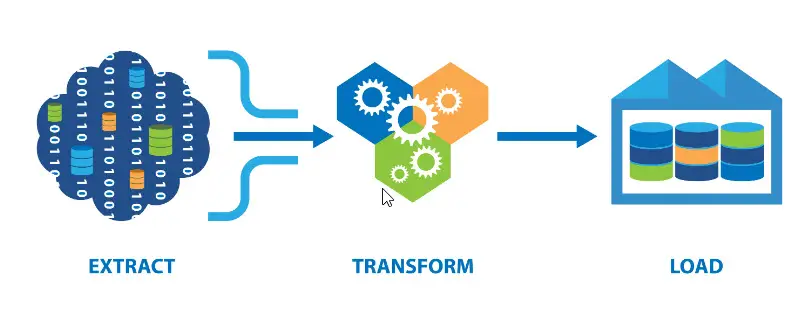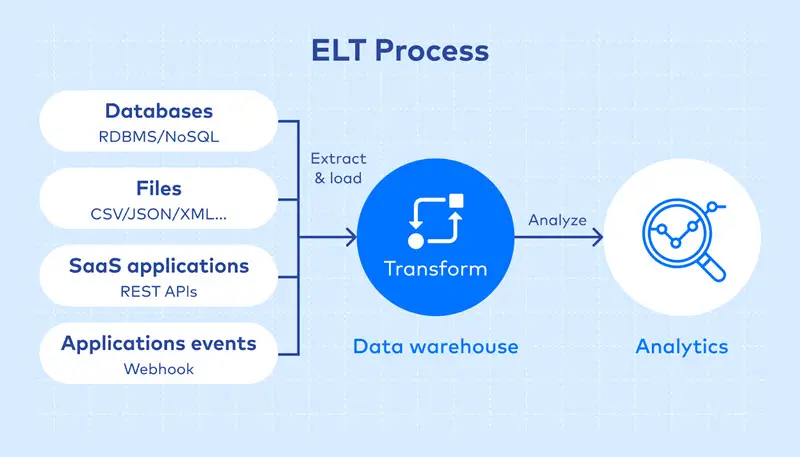The main task of ETL and ELT systems is to structure, enrich, optimize, and transfer the company’s initial data from several software shells to a single centralized storage database for further processing.
ETL and ELT are two progressive approaches, each with specific benefits. If you are looking for a reliable data engineering services provider and want to understand the differences between ETL and ELT, this article is for you. You will learn about the specifics of each model and understand in which cases it is better to use each of these solutions.
What Is ETL And ETL?
ETL is a model that works on the Extract, Transform, and Load principle. Information obtained from different sources, processed in accordance with the algorithms of directories of various IT systems and having an unequal degree of detail, is brought into a single format and becomes suitable for further processing. The next task of ETL is the delivery of data, which should be carried out in the fastest way without loss of quality and reliability.
ELT systems differ in the sequence of actions performed: Extract, Load, and Transform. The data is first received and downloaded and only then processed. The ELT model works with huge arrays of asynchronous data, developing impressive speed. It uses cloud computing resources that can be scaled without using local hardware.
Thus, ELT implies not only a change in the sequence of actions but also a qualitatively new approach to the data transformation process.
How ETL Works
ETL prepares data for further analytics immediately after it is uploaded. To do this, the system extracts information from various databases, clears errors, and leads to a single format and level of detail.
The main advantages of ETL are:
- A well-learned process that is easy to maintain at a professional level. There are a large number of time-tested ETL tools and platforms;
- High-quality preparation of data for analysis – after uploading the information, it can be used for study without additional adjustment;
- Having an audit trail to trace the origin of the data.
ETL qualitatively organizes the source information, preparing it for the processes of visualization, modeling, and further transformation.

The use of ETL systems for data preparation is often justified. They are quite reliable and designed according to the user’s needs. However, ETL systems have several drawbacks:
- Significant time costs. To consolidate data, it is necessary to develop uniform requirements that should apply to various sources of information. Implementation can take weeks or even months. It will also take a lot of time to update the target repository.
- Lack of flexibility. Data pipelines are initially designed in accordance with the current specifics of information sources and user goals. As data sources increase or new use cases emerge, the system needs to be re-engineered.
- Dependence of data transfer on the correctness of the processes of their transformation. If an error occurs at one of the preparatory stages, the upload of information stops.
- Restricting access to source data for end users. Only specialists involved in their transformation have it.
How ELT Works?
Speeding up the process of transferring information to the ELT is achieved by optimizing the approach due to a change in the sequence of operations. First, the data is retrieved and loaded and only then processed. Cloud technologies are involved in the process of their transformation, which makes it possible to perform optimization quickly and imperceptibly for the user.
In this case, the user can use a single repository for the needs of various applications. Unlike preparing information in a pipeline, the original data will not be lost. A replica is created to solve a specific problem. The presence of such an intermediate database allows you to return to the study of the original information many times without making technical changes to the ELT system.

A feature of ELT is also the gradual processing of information, which is carried out as requests are formed.
With ELT, you can quickly manage large or ever-growing amounts of data. The main advantages of such a system include:
- High speed. Firstly, the process of data transfer is not preceded by their preliminary preparation within the system. Secondly, cloud services use information designed to interact quickly with large amounts of data. Interactive self-service analytics become available in real-time.
- Flexibility. The data is transformed in accordance with the requests of specific users at the time of direct access and can be used for various purposes repeatedly. In this case, you do not have to configure processes at the level of the ELT system.
- Scalability. Data growth is not a problem for ELT or cloud storage.
- Transparency. Users are promptly informed about what data is available for study.
- Low operating costs. When using cloud-based ELT, there is no need to invest in local equipment and modify the system as business needs for analytics expand or data volumes increase. You pay only for the amount of cloud services you use.
What to Choose: ETL or ELT?
Today, both systems are able to meet the needs of the business. ETL tools effectively interact with small amounts of information that need complex transformation but do not require too frequent updates. In contrast, an ELT system can quickly transfer large amounts of data, the regular updating of which is critical.
There are companies that successfully use both methods of preparing and delivering information. Working in parallel, ETL and ELT are able to satisfy a variety of business needs and demands. An example is the use of ETL to examine regular reporting that is not updated very often. At the same time, ELT is used in areas where rapid response is critical. Accordingly, the information can be loaded every minute or every second.
Conclusion
ETL and ELT are an important part of the data engineering process, providing data preparation, transformation, and loading for effective use in business and analysis. If you are looking for a reliable data engineering services provider, we recommend that you contact Mydigicode.com. The company has impressive experience in providing services such as data warehousing, data integration, ETL development, etc.






